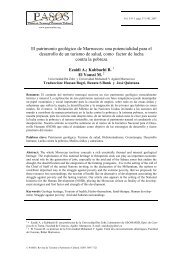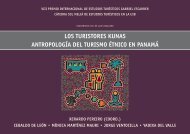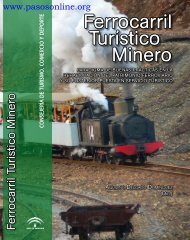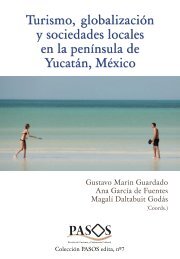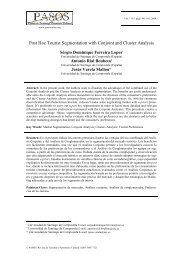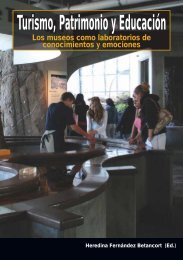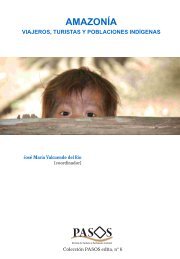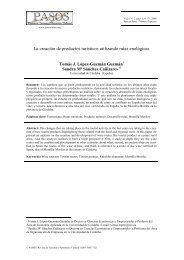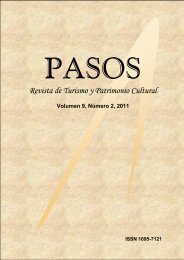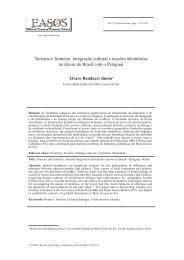Full Journal - Pasos
Full Journal - Pasos
Full Journal - Pasos
Create successful ePaper yourself
Turn your PDF publications into a flip-book with our unique Google optimized e-Paper software.
94 Repositioning of Barcelona’s Image in the Light of a Redefinition of the Urban Tourism Planning Model<br />
cina Pla Estratègic Turisme Barcelona 2015,<br />
2010). Second, the setting up of various strategic<br />
business groups set up by the Barcelona Tourist<br />
Board such as the health, sports, and university<br />
clusters, among others.<br />
––<br />
We analysed eighty two items from eleven<br />
European tourist cities to create The Tourism<br />
Innovation Capacity of Barcelona Index, 2008<br />
(Anex). The items chosen were based on the<br />
following four fields:<br />
––<br />
Territorial limits (surface area); demography<br />
(population and density) economic (unemployment<br />
rate); GDP per capita; % service sector<br />
and GDP; economy’s growth rate). Transport<br />
connections by air, train, bus and underground,<br />
stressing journey times and intermodal<br />
transport. In the case of air transport,<br />
the following were taken into account: number<br />
of domestic and international flights; annual<br />
passenger traffic; number of airports; cities<br />
linked by air. In the case of railways: the<br />
number of high-speed rail stops; cities within<br />
one hour’s travelling distance. In the cases of<br />
bus and underground services: the number of<br />
kilometres of lines and service frequency.<br />
––<br />
Tourism competitiveness; number and origin<br />
of tourists; ratio of tourists to residents;<br />
occupation rates; attractions linked to culture<br />
and monuments; number of visitors to main<br />
monuments; the structure of accommodation<br />
and cultural offerings.<br />
––<br />
Components of excellence for a creative city;<br />
training; universities and leading business<br />
schools; number of doctorates; scientific<br />
production in terms of journal articles and<br />
patents; percentage of population engaged in<br />
R&D; international presence; level of research<br />
and inhabitants’ use of technology.<br />
We have taken these four index groups<br />
– basics, connectivity, tourism and creative<br />
society – to obtain a more clear positioning of<br />
European cities, taking into account the competitive<br />
vision of the city as per projected in this<br />
paper. We consider that indicator packets such<br />
as the World Economic Forum, WEF 2011, and<br />
the World Travel and Tourism Council, WTTC<br />
2001, are extremely valuable for countries from<br />
the tourist perspective. However, the peculiarity<br />
of European cities and their current competitive<br />
environment forces us to present this<br />
indicator model that integrates elements related<br />
to infrastructure, connectivity aspects, strictly<br />
tourist aspects and the idea of creative society.<br />
Secondary sources were used which were categorized<br />
from 1 to 5 (1, lowest; 5, highest). In<br />
order to obtain the synthetic index, a compendium<br />
of all, it is presented weighted on a scale<br />
of 1-10 (1, least relevant, 10, most important),<br />
and through this weighting the relative values<br />
of each indicator have been calculated for each<br />
city. The sum of the relative values, arranged<br />
Figure 1: Barcelona 1990-2010<br />
1990 2010<br />
Tourists 1,700,000 7,100,000<br />
Overnight stays 3,700,000 14,000,000<br />
Holiday 22.7 % 50.1<br />
Business and other 77.3 % 49.9 %<br />
Passengers, El Prat airport 9,048,600 29,209,500<br />
Cruise passengers 115,100 2,350,200<br />
Hotel rooms 10,200 35,800<br />
Tourist attractions (1.3 m tourists a<br />
year and upwards)<br />
Sagrada Familia (2.3 m); Cosmo-<br />
Caixa [Science Museum] (2.1 m);<br />
Aquarium (1.6 m); CaixaForum [Art<br />
& Cultural Centre] (1.5 m); Picasso<br />
Museum (1.3 m); Barcelona F.C.<br />
Museum (1.3 m)<br />
Tourist Bus [‘Bus Turístic’] users 23,700 1,925,200<br />
BCN Card users 10,200 130,700<br />
BCN Walking Tour users 1,500 15,200<br />
Source: data taken from Turisme Barcelona, 2011<br />
PASOS. Revista de Turismo y Patrimonio Cultural, 11(1). 2013 ISSN 1695-7121



